Boost Participation: Increase Engagement in Virtual Meetings
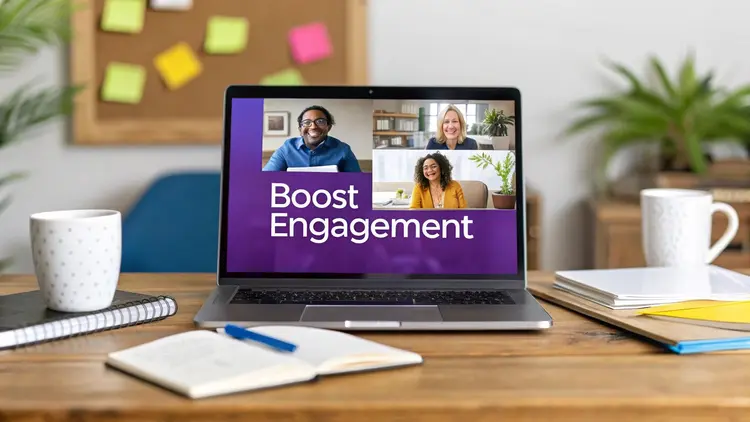
Maximize Your Virtual Meeting Impact
Virtual meetings are essential for modern business, but often struggle with low engagement. This listicle offers eight proven techniques to transform your online gatherings into dynamic, interactive experiences that deliver results. Learn how to increase engagement in virtual meetings by implementing these actionable strategies. We'll explore tactics like gamification, visual storytelling, interactive whiteboards, and more.
These techniques can revitalize your virtual meetings regardless of industry or team size. We go beyond generic advice to provide specific, implementable strategies. Effective virtual meetings foster collaboration, improve communication, and ultimately boost productivity. This listicle gives you the tools to achieve those outcomes. Ready to revitalize your online meetings? Let's dive in.
1. Interactive Polling and Real-Time Feedback
Transform passive listeners into active participants with interactive polling and real-time feedback. These tools solicit immediate responses, opinions, and feedback on topics discussed, fostering a more engaging virtual meeting experience. This approach helps gauge audience understanding, gather valuable insights, and keep attendees focused. It moves beyond simple Q&A, creating a dynamic two-way conversation.
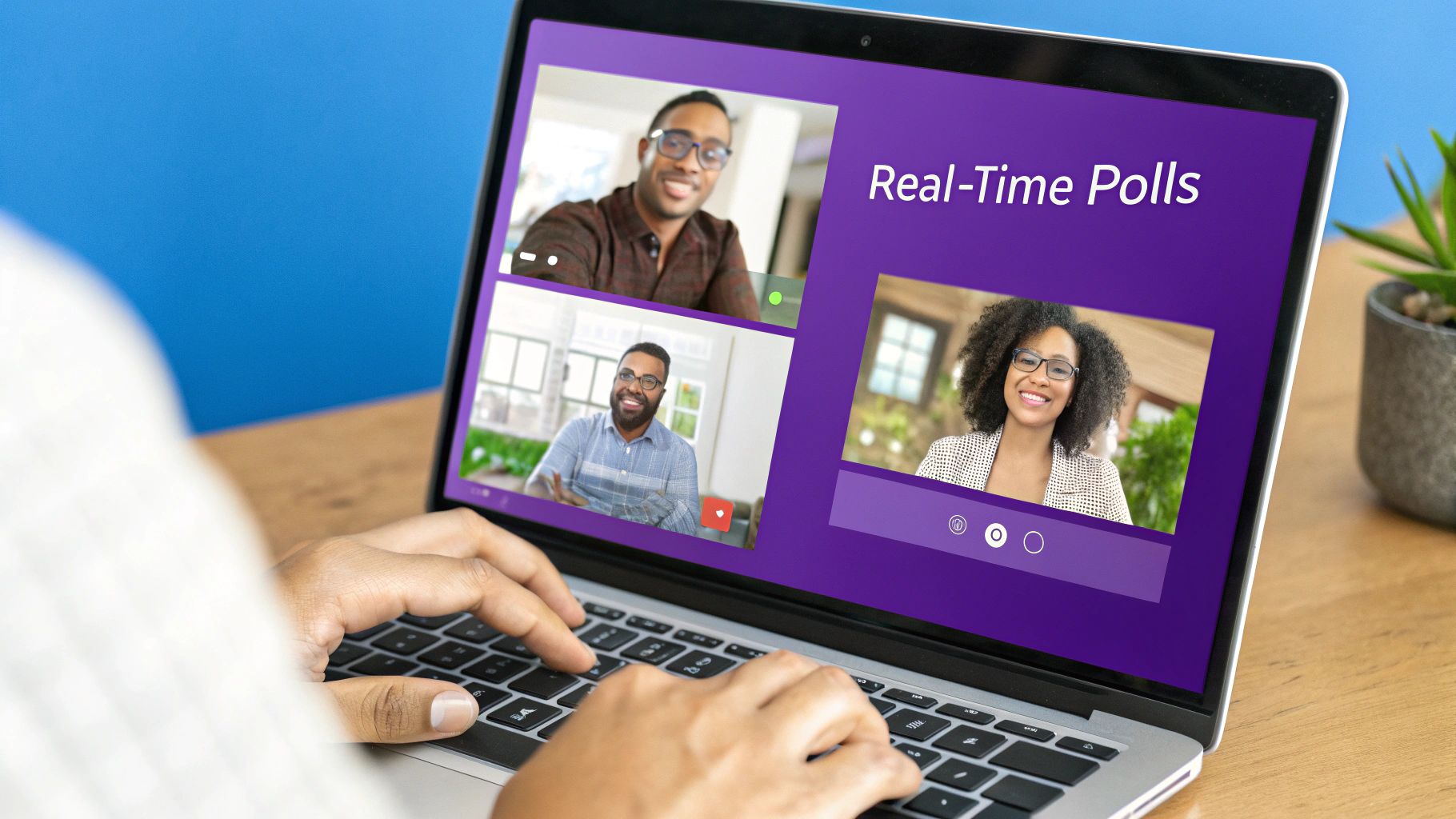
Real-World Examples
Several organizations leverage real-time feedback effectively. Microsoft uses live polls during all-hands meetings to gauge employee sentiment. Universities utilize platforms like Mentimeter to boost student engagement in virtual lectures. Salesforce incorporates Slido polls into their quarterly business reviews to gather feedback and drive discussions. These examples demonstrate the versatility of real-time feedback across different contexts.
Actionable Tips for Implementation
Frequent Polls: Use polls every 10-15 minutes to maintain engagement and prevent attention drift.
Thought-Provoking Questions: Ask open-ended or multiple-choice questions that stimulate critical thinking, rather than simple yes/no queries.
Immediate Results Sharing: Display poll results instantly to maintain momentum and encourage further discussion. Transparency builds trust and further motivates participation.
Backup Questions: Prepare backup questions in anticipation of unexpected responses or to delve deeper into specific areas of interest.
Technical Readiness: Test your chosen polling tools before the meeting starts to ensure seamless integration and avoid technical glitches.
When and Why to Use Real-Time Feedback
Interactive polls are incredibly valuable in a variety of scenarios. Use them to:
Increase engagement in virtual meetings: Combat meeting fatigue and keep attendees actively involved.
Gather immediate feedback: Understand audience perspectives and adjust your presentation accordingly.
Facilitate decision-making: Leverage collective intelligence to reach consensus and drive effective outcomes.
Enhance learning and knowledge retention: Test comprehension and reinforce key concepts during virtual training sessions or webinars.
Boost interactivity in large meetings: Foster a sense of community and encourage participation even in large virtual gatherings.
By implementing interactive polling and real-time feedback mechanisms, you can transform your virtual meetings from passive presentations into dynamic, engaging conversations. Tools like Mentimeter, Slido (acquired by Cisco), and Poll Everywhere, as well as the Microsoft Teams Live Polls feature, make implementing this strategy straightforward and effective. This technique elevates audience participation, generating valuable insights and ensuring a more impactful meeting experience.
2. Breakout Room Collaboration
Transform your virtual meetings from passive lectures into dynamic, interactive sessions by leveraging breakout room collaboration. This technique involves strategically dividing larger virtual meetings into smaller breakout rooms where participants can engage in focused discussions, brainstorming sessions, or collaborative activities. This approach mimics the natural small-group dynamics of in-person meetings, fostering deeper engagement and richer interactions. Breakout rooms create a sense of intimacy and encourage active participation, particularly in larger virtual gatherings where individual voices can be lost.
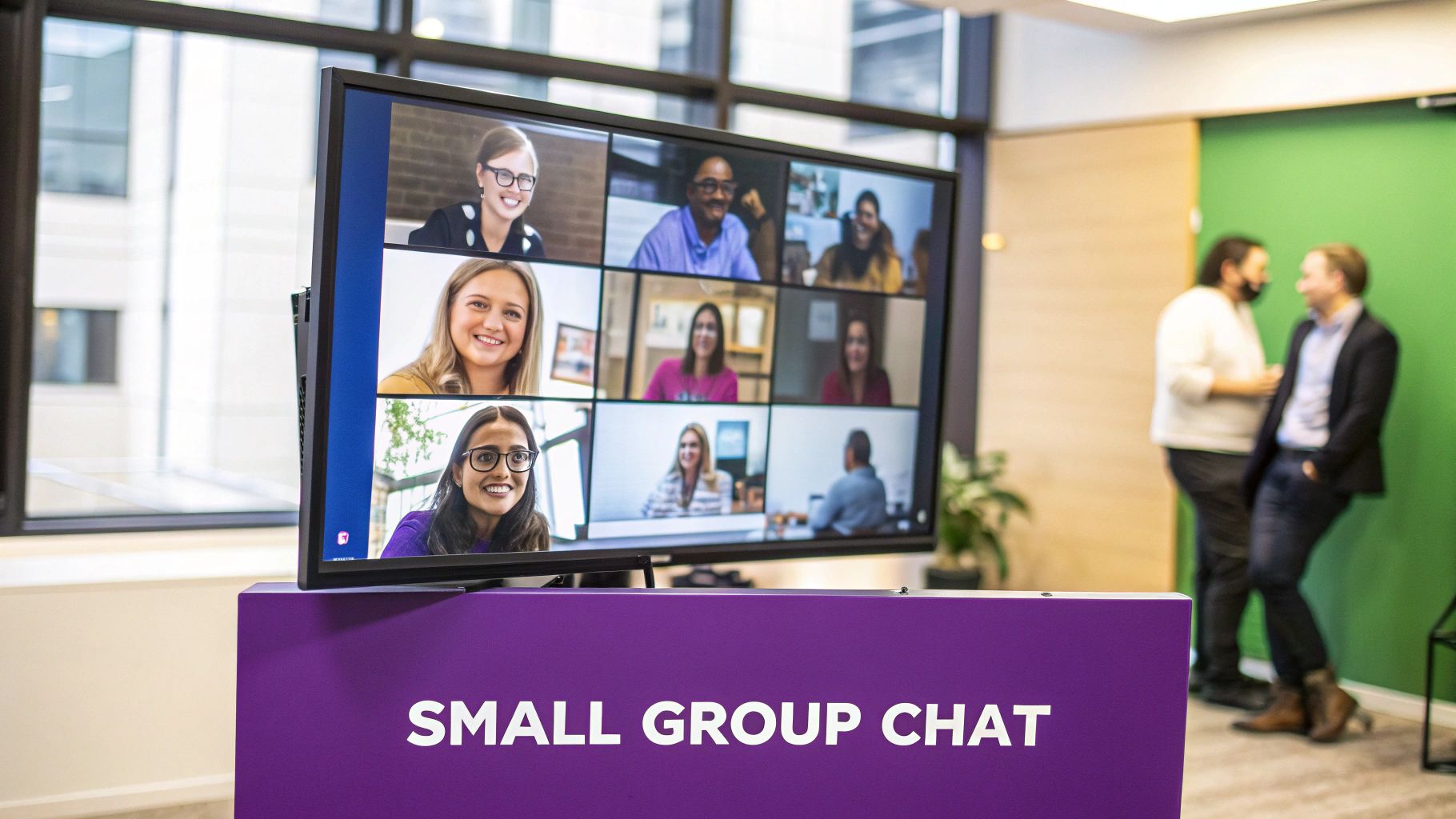
Real-World Examples
Numerous organizations utilize breakout rooms to enhance virtual collaboration. Accenture uses breakout rooms for design thinking workshops, fostering creative problem-solving. Educational institutions conduct virtual group projects within breakout rooms, promoting teamwork and peer learning. Agile teams use breakouts for sprint retrospectives, facilitating open communication and reflection. IBM holds virtual innovation sessions with cross-functional teams in breakout rooms to spark new ideas and drive collaborative projects.
Actionable Tips for Implementation
Clear Instructions and Objectives: Before splitting participants, provide clear instructions and well-defined objectives for the breakout session. This ensures everyone understands the purpose and desired outcomes.
Designated Roles: Assign a facilitator or note-taker for each room to guide the discussion, capture key insights, and ensure productive outcomes.
Time Management: Set specific time limits for breakout sessions and provide regular time warnings to keep groups on track and focused.
Group Rotation: Rotate group compositions between breakout sessions to encourage diverse interactions and cross-pollination of ideas.
Report Back: Have groups report back to the main session with key insights, decisions, or action items generated during their breakout discussions.
When and Why to Use Breakout Rooms
Breakout room collaboration is invaluable in several scenarios to increase engagement in virtual meetings. Consider using them to:
Facilitate Brainstorming: Generate creative ideas and solutions through focused group discussions.
Encourage Team Building: Foster stronger connections and rapport within teams.
Deepen Discussions: Enable more in-depth conversations on complex topics in smaller, more intimate settings.
Problem Solving: Leverage collective intelligence to tackle challenges and develop innovative solutions.
Enhance Learning: Create opportunities for peer-to-peer learning and knowledge sharing.
By strategically implementing breakout room collaboration, you can revitalize your virtual meetings. Popular platforms like Zoom, Microsoft Teams, and Google Meet offer built-in breakout room functionality, simplifying implementation. This technique transforms passive attendees into active participants, driving richer discussions, stronger team dynamics, and more productive virtual meetings.
3. Gamification Elements
Transform your virtual meetings from mundane gatherings into engaging experiences by incorporating game-like elements. Points, badges, leaderboards, challenges, and friendly competitions can tap into the psychological drivers of achievement and recognition, significantly boosting participant interaction. This approach injects fun and excitement, making meetings more memorable and productive.
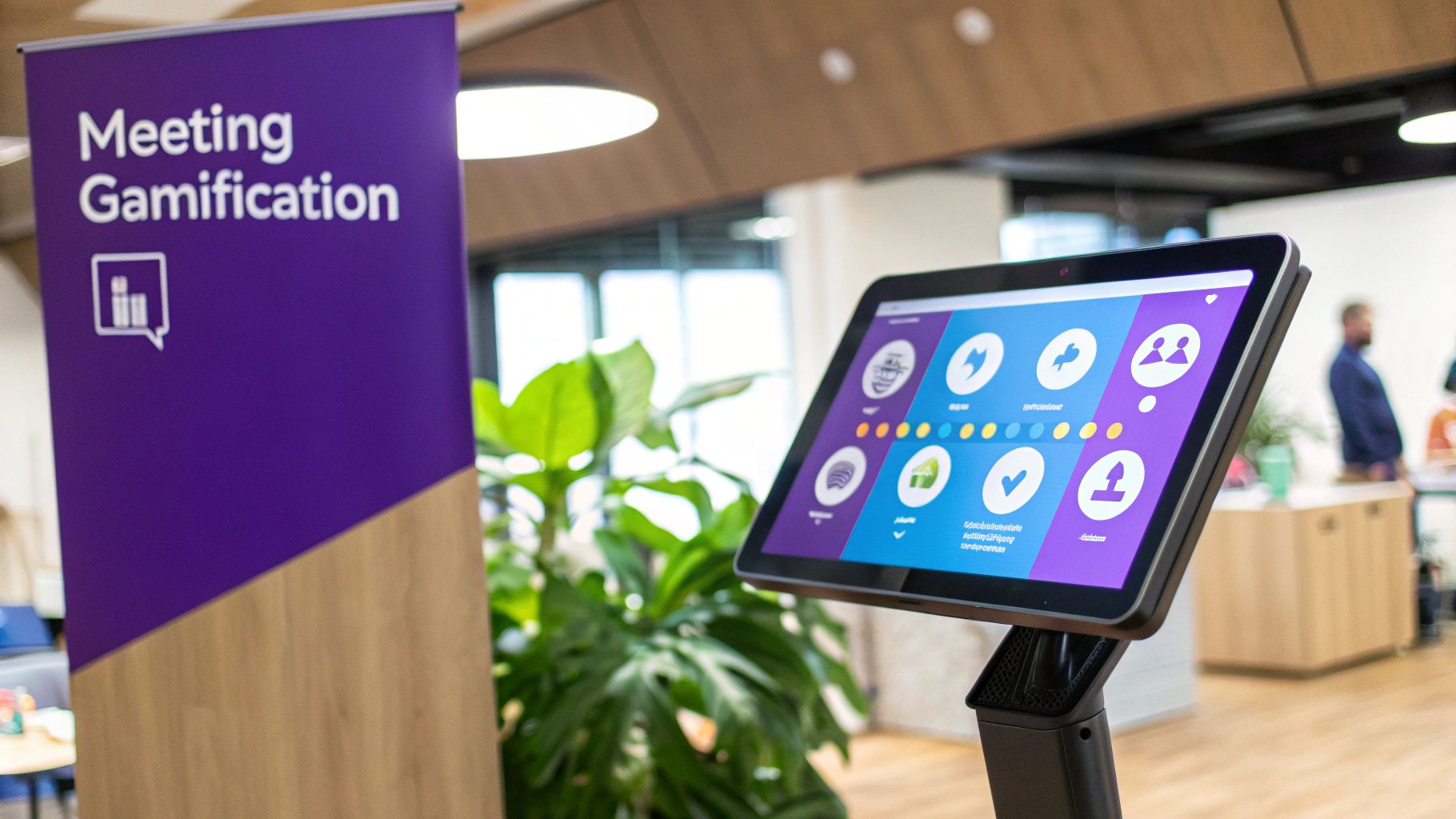
Real-World Examples
Many organizations are successfully integrating gamification into their virtual meetings. Deloitte, for instance, uses achievement systems in their virtual training programs to enhance learning and engagement. Sales teams are leveraging gamified CRM integration to incentivize meeting participation and track performance. Kahoot! quizzes are a popular choice for boosting interactivity in corporate training sessions. Microsoft also uses gamification in its employee onboarding programs to foster a sense of community and accelerate the learning process.
Actionable Tips for Implementation
Alignment with Objectives: Ensure that the games align with the meeting's objectives and overall company culture for a seamless integration.
Simple Scoring: Keep the scoring system simple and transparent to avoid confusion and maintain focus on the meeting content.
Meaningful Rewards: Offer rewards that are meaningful to participants, even if modest, to encourage active participation.
Variety of Games: Rotate different types of games to maintain novelty and prevent participants from becoming disengaged.
Individual and Team Elements: Include both individual and team-based game elements to foster collaboration and healthy competition.
When and Why to Use Gamification
Gamification can significantly increase engagement in virtual meetings, especially when:
Combating Meeting Fatigue: Introduce game elements to re-energize participants and maintain focus during long virtual sessions.
Enhancing Learning and Training: Gamified learning activities can improve knowledge retention and make training more enjoyable.
Driving Team Collaboration: Team-based challenges and competitions can strengthen team dynamics and encourage collaborative problem-solving.
Boosting Participation in Large Meetings: Gamification can create a sense of community and encourage participation even in large virtual gatherings.
Making Meetings More Enjoyable: Simply put, games add an element of fun, making meetings more enjoyable and memorable for everyone.
By incorporating gamification elements, you can transform passive attendees into active participants, making virtual meetings more engaging and productive. Tools like Kahoot!, Mentimeter, Microsoft Viva Insights, and Salesforce Trailhead offer various gamification features to facilitate implementation. This approach leverages the power of play and friendly competition to boost engagement and achieve meeting objectives more effectively.
4. Visual Storytelling and Rich Media
Transform your virtual meetings from mundane to memorable by leveraging the power of visual storytelling and rich media. Incorporating compelling visuals, multimedia content, and narrative techniques captivates your audience and reinforces key messages. This approach moves beyond static slides, creating a more dynamic and engaging virtual meeting experience. Interactive presentations, videos, animations, infographics, and visual metaphors can significantly enhance understanding and retention.
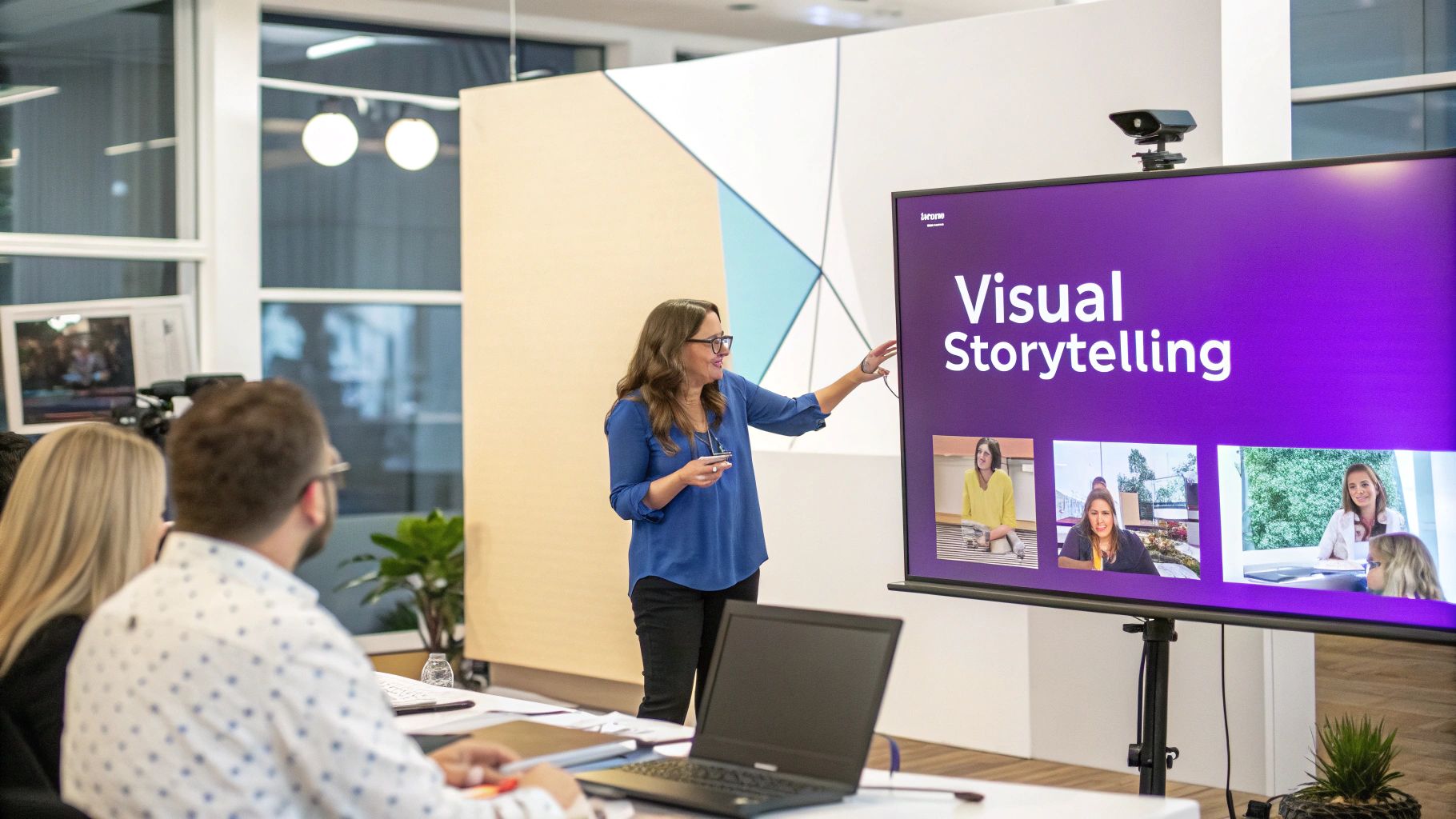
Real-World Examples
Many organizations successfully utilize rich media to elevate their virtual meetings. TED Talks, renowned for their compelling storytelling approach, offer a model adaptable for corporate settings. Prezi, with its dynamic, non-linear presentation style, provides an engaging alternative to traditional slide decks for project updates. Collaborative platforms like Miro and Mural facilitate visual brainstorming and interactive workshops. Even Netflix leverages rich media for internal strategy presentations, demonstrating the versatility of this technique.
Actionable Tips for Implementation
6x6 Rule: Maximum 6 bullet points, 6 words each.
Short Videos: Incorporate relevant videos under 2 minutes.
Visual Clarity: High-contrast colors, large fonts for screens.
Story Structure: Beginning, middle, and end for narratives.
Technical Check: Test all multimedia elements beforehand.
When and Why to Use Visual Storytelling
Visual storytelling enhances various virtual meeting types. Use it to:
Increase engagement in virtual meetings: Combat meeting fatigue.
Explain complex information: Simplify data visualization.
Boost information retention: Memorable visual narratives.
Facilitate collaboration: Interactive visual workspaces.
Make presentations impactful: Captivate and persuade audiences.
By incorporating visual storytelling and rich media, you can transform your virtual meetings into immersive experiences. Tools like Prezi, Canva, Miro, and Mural make implementing this strategy accessible. This technique fosters deeper understanding, strengthens audience connection, and increases the impact of your virtual meetings.
5. Camera-On Culture and Non-Verbal Engagement
Transform your virtual meetings from a collection of static profile pictures to a dynamic, engaging experience by cultivating a camera-on culture. Encouraging participants to turn on their cameras and actively use non-verbal communication significantly enhances the virtual meeting environment. This fosters a sense of presence, connection, and facilitates richer interactions by allowing for visual cues like facial expressions and body language. It moves beyond simple verbal communication, creating a more personal and engaging meeting experience.
Real-World Examples
Several organizations successfully leverage camera-on policies. GitLab, renowned for its all-remote culture, often employs mandatory camera usage for certain meetings, emphasizing the importance of face-to-face interaction, even virtually. Shopify encourages camera usage in their virtual-first meeting guidelines to promote team cohesion. Buffer champions a transparent camera-on policy, fostering a sense of inclusivity and shared presence. These examples highlight how prioritizing visual presence can strengthen connections within virtual teams.
Actionable Tips for Implementation
Establish Clear Expectations: Communicate clear, yet flexible, camera-on expectations from the outset. Acknowledge potential challenges and provide reasonable exceptions.
Optimize Visuals: Encourage participants to optimize their lighting and camera positioning for a professional appearance. Simple adjustments can significantly enhance the overall meeting experience.
Utilize Platform Features: Encourage the use of built-in platform features like reactions and hand-raising to foster non-verbal communication and active participation.
Address Privacy Concerns: Proactively address any privacy or comfort concerns participants may have regarding camera usage. Offer alternative engagement options if necessary.
Lead by Example: Leaders and meeting facilitators should consistently use their cameras to set the tone and encourage others to follow suit.
When and Why to Use Camera-On Engagement
A camera-on culture is particularly valuable when:
Building rapport and connection: Fostering stronger relationships within teams, especially newly formed or geographically dispersed ones.
Improving communication clarity: Non-verbal cues enhance understanding and minimize misinterpretations, particularly during complex discussions.
Increasing engagement in virtual meetings: Combatting meeting fatigue and promoting active participation.
Creating a more inclusive environment: Facilitating a sense of shared presence and connection, especially for remote team members.
Facilitating collaborative brainstorming: Visual cues can stimulate creativity and enhance idea generation during brainstorming sessions.
By fostering a camera-on culture and promoting the use of non-verbal communication, you can create a more dynamic, engaging, and ultimately more effective virtual meeting experience. This approach transforms passive observers into active participants, enriching communication and strengthening team cohesion. This technique elevates the overall meeting experience, fostering deeper connection and leading to more productive outcomes.
6. Structured Participation and Speaking Protocols
Transform your virtual meetings from chaotic free-for-alls to productive, engaging sessions with structured participation and speaking protocols. These methods provide organized ways to manage speaking turns, ensuring equal participation and creating structured opportunities for all attendees to contribute meaningfully. This fosters a sense of inclusivity and maximizes the value extracted from each participant's input.
Real-World Examples
Many organizations already benefit from structured participation. Agile teams utilize stand-up meetings with structured check-ins to keep projects on track. Academic virtual seminars often feature moderated discussions with designated speakers and Q&A periods. Formal board meetings thrive on established speaking protocols, ensuring efficient decision-making. Design critique sessions use structured feedback rounds to provide clear and actionable input.
Actionable Tips for Implementation
Rotate Speaking Order: Implement a round-robin approach to give everyone a chance to speak, promoting fairness and engagement.
Visible Timers: Use timers for speaking segments to keep the discussion focused and prevent any one individual from dominating the conversation.
Designated Roles: Assign roles like timekeeper and note-taker to ensure smooth meeting flow and accurate record-keeping.
Balanced Discussion: Allow time for both structured contributions and open discussion to accommodate different communication styles and topics.
Hand-Raising Feature: Encourage participants to use the hand-raising feature in video conferencing platforms to signal their desire to speak, maintaining order and respect.
When and Why to Use Structured Participation
Structured participation methods are particularly effective when:
Increase engagement in virtual meetings: Facilitate inclusive discussions where everyone feels comfortable contributing, leading to increased engagement.
Managing Large Groups: Maintain order and ensure everyone gets a chance to speak in larger virtual meetings.
Decision-Making: Streamline decision-making processes by ensuring all perspectives are heard in a structured manner.
Equalizing Participation: Encourage contributions from quieter individuals who might otherwise hesitate to speak up.
Time Management: Stay on schedule and maximize meeting efficiency by allocating specific time slots for different speakers and topics.
By implementing structured participation and speaking protocols, you can ensure a more equitable and productive virtual meeting experience. These techniques promote inclusivity, maximize participation, and facilitate more effective communication, ultimately leading to better outcomes and increased engagement in virtual meetings. Methods like round-robins, timed contributions, and designated roles create a predictable and respectful environment, empowering all attendees to contribute meaningfully.
7. Interactive Whiteboards and Real-Time Collaboration
Transform your virtual meetings from passive observation to dynamic engagement with interactive whiteboards and real-time collaboration tools. These platforms allow multiple participants to contribute simultaneously through drawing, writing, sticky notes, and visual brainstorming. This creates a shared virtual workspace fostering creative collaboration and increasing engagement in virtual meetings. This approach effectively combats meeting fatigue and encourages active participation from all attendees.
Real-World Examples
Many organizations leverage interactive whiteboards for effective virtual collaboration. IDEO utilizes Miro for virtual design thinking workshops, enabling remote teams to brainstorm and develop innovative solutions. Spotify uses Mural for remote team brainstorming sessions, capturing ideas visually and fostering a collaborative environment. Microsoft Teams Whiteboard facilitates project planning within the familiar Teams interface, streamlining teamwork. Figma serves as a powerful tool for collaborative design reviews, allowing real-time feedback and iteration.
Actionable Tips for Implementation
Provide Brief Tool Tutorials: Before collaborative sessions, offer concise tutorials to familiarize participants with the chosen whiteboard platform. This ensures everyone can contribute effectively.
Use Templates: Leverage pre-built templates to structure activities and guide brainstorming sessions. Templates save time and provide a framework for productive collaboration.
Assign Colors or Sections: Allocate specific colors or sections of the whiteboard to different participants or teams. This helps organize ideas and facilitates clear communication.
Set Clear Objectives: Define specific goals for whiteboard activities. This ensures focused collaboration and measurable outcomes.
Save and Share Results: After the meeting, save and share the whiteboard content with all participants. This provides a valuable record of the collaborative process.
When and Why to Use Interactive Whiteboards
Interactive whiteboards are incredibly valuable in a variety of scenarios. Use them to:
Brainstorming and Ideation: Generate new ideas and solutions collaboratively.
Project Planning and Management: Visualize project timelines, tasks, and dependencies.
Design Thinking Workshops: Facilitate collaborative design processes and user research.
Team Building Activities: Engage remote teams in interactive exercises that foster connection and collaboration.
Meeting Notes and Documentation: Capture key decisions, action items, and insights visually.
By implementing interactive whiteboards and real-time collaboration tools like Miro, Mural, Microsoft Whiteboard, and Figma, you can transform your virtual meetings into dynamic, engaging sessions. These tools empower participants to contribute actively, fostering creativity, enhancing communication, and increasing engagement in virtual meetings, leading to more productive and impactful outcomes.
8. Pre-Meeting Engagement and Follow-Up Systems
Transform your virtual meetings from isolated events into a continuous engagement cycle with pre-meeting preparation and robust follow-up systems. These strategies extend engagement beyond the meeting itself, fostering a sense of shared purpose and driving tangible outcomes. This approach creates a more cohesive and productive virtual meeting experience.
Real-World Examples
Several organizations demonstrate the power of integrated engagement strategies. Atlassian utilizes team playbooks with defined pre- and post-meeting activities for streamlined workflows. Google incorporates OKR check-ins with continuous tracking to monitor progress and maintain accountability. Slack channels dedicated to meeting follow-up facilitate ongoing discussions and knowledge sharing. Asana project management integration with meeting outcomes ensures action items are assigned and tracked effectively.
Actionable Tips for Implementation
Advance Preparation: Send the agenda and any preparatory materials 24-48 hours in advance. This allows participants to arrive prepared and contribute meaningfully.
Collaborative Agenda Building: Use collaborative tools to build the meeting agenda, encouraging input and ownership from all attendees.
Template Follow-Up Communications: Create template follow-up communications to streamline post-meeting summaries and action item assignments.
Automated Reminders: Set up automated reminders for action items to keep everyone on track and accountable.
Regular Check-Ins: Establish regular progress check-in rhythms to maintain momentum between meetings and monitor progress towards goals.
When and Why to Use Pre-Meeting Engagement and Follow-Up Systems
Pre-meeting engagement and follow-up systems are valuable for various meeting types. Use them to:
Increase engagement in virtual meetings: Extend the meeting's impact beyond the scheduled time, creating a more continuous flow of interaction.
Improve meeting productivity: Prepare participants and ensure follow-through on action items, leading to tangible outcomes.
Foster a sense of shared purpose: Involve participants in the meeting process from start to finish, creating a stronger sense of ownership.
Facilitate continuous improvement: Regular check-ins and feedback loops allow for continuous refinement of meeting processes and objectives.
Strengthen team collaboration: Extend communication and collaboration beyond the meeting itself, promoting a stronger team dynamic.
By implementing pre-meeting engagement and robust follow-up systems, you can create a more cohesive and productive virtual meeting experience. Tools like Monday.com, Notion, Slack, and Microsoft Viva Goals can help streamline these processes and drive meaningful outcomes. This holistic approach transforms isolated meetings into interconnected touchpoints within a larger framework of collaboration and progress. It maximizes the value of each interaction and fosters a culture of continuous engagement.
8-Strategy Engagement Methods Comparison
Engagement Method | Implementation Complexity 🔄 | Resource Requirements ⚡ | Expected Outcomes 📊 | Ideal Use Cases 💡 | Key Advantages ⭐ |
|---|---|---|---|---|---|
Interactive Polling and Real-Time Feedback | Medium | Requires software integration | Immediate feedback, increased participation | Large virtual meetings needing active engagement | Boosts focus, data-driven insights, anonymous input |
Breakout Room Collaboration | Medium to High | Platform with breakout features | Enhanced small group interaction | Workshops, brainstorming, training sessions | Increases speaking time, reduces anxiety, parallel topics |
Gamification Elements | High | Ongoing management, gamification tools | Higher participation, engagement, retention | Training, long meetings, corporate learning | Motivates through competition, memorable sessions |
Visual Storytelling and Rich Media | Medium to High | Content creation tools, higher bandwidth | Better comprehension, memorable meetings | Presentations requiring clear explanation, education | Supports diverse learning styles, breaks monotony |
Camera-On Culture and Non-Verbal Engagement | Low to Medium | Video-capable hardware, bandwidth | Stronger connections, natural flow | Remote teams valuing personal interaction | Builds accountability, reads body language |
Structured Participation and Speaking Protocols | Medium | Facilitation skills, time management tools | Equal participation, efficient meetings | Formal meetings, academic seminars, agile stand-ups | Prevents domination, improves focus, predictable flow |
Interactive Whiteboards and Real-Time Collaboration | Medium | Digital whiteboard platforms | Creative outputs, visual collaboration | Design thinking, project planning, brainstorming | Enables visual thinking, simultaneous input |
Pre-Meeting Engagement and Follow-Up Systems | High | Collaboration and tracking tools | Improved prep, follow-through, continuous engagement | Complex projects, ongoing team alignment | Maximizes ROI, continuous momentum, better prep |
Transform Your Virtual Meetings Today
This article explored eight powerful strategies to increase engagement in virtual meetings. From leveraging interactive tools like polls and whiteboards to fostering a camera-on culture and implementing structured participation, these techniques offer a roadmap to transform passive online gatherings into dynamic collaborative sessions. By focusing on real-time feedback, visual storytelling, and gamification, you can create virtual meetings that are not only productive but also enjoyable for all participants.
Key Takeaways for Increased Engagement
Let's recap the most impactful takeaways for increasing engagement and transforming your virtual meetings:
Prioritize Interaction: Don't let your meetings become webinars. Interactive elements like polls, Q&A sessions, and breakout rooms are crucial for maintaining participant focus.
Visualize and Engage: Move beyond static slides. Incorporate rich media, visual storytelling, and interactive whiteboards to captivate your audience and foster collaboration.
Structure and Facilitate: Establish clear speaking protocols and utilize structured participation techniques to ensure everyone feels heard and valued.
Foster Connection: Encourage a camera-on culture to promote non-verbal engagement and build stronger connections between participants.
Plan and Follow Up: Pre-meeting engagement and robust follow-up systems are essential for maximizing the impact of your virtual gatherings.
The Power of Engaged Virtual Meetings
Mastering these techniques is more than just a matter of improving online meetings; it's about unlocking the full potential of virtual collaboration. Increased engagement leads to better decision-making, stronger team cohesion, and ultimately, more successful outcomes. In today's increasingly remote and hybrid work environments, effective virtual communication is no longer a luxury, it's a necessity. By embracing these strategies, you're investing in a more productive and connected future for your team.
Taking Your Virtual Meetings to the Next Level
Remember, the key to success is experimentation and adaptation. Tailor these strategies to your specific team dynamics and organizational culture. Explore different tools and techniques to find what resonates best with your audience. Consistently aim for a high-engagement virtual meeting environment to ensure a successful transition to the future of work. Want to further elevate your virtual presentations and foster deeper audience connection? Explore SpeakerStacks, a platform designed to enhance audience engagement through interactive Q&A, live polling, and feedback features. Visit SpeakerStacks to learn how you can transform your virtual meetings into truly captivating experiences.